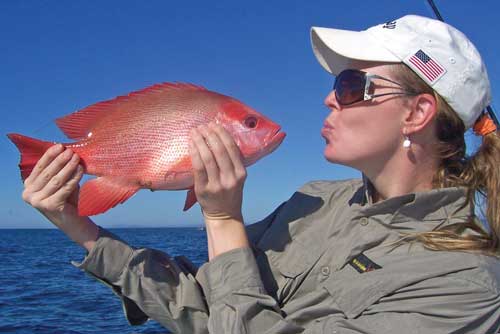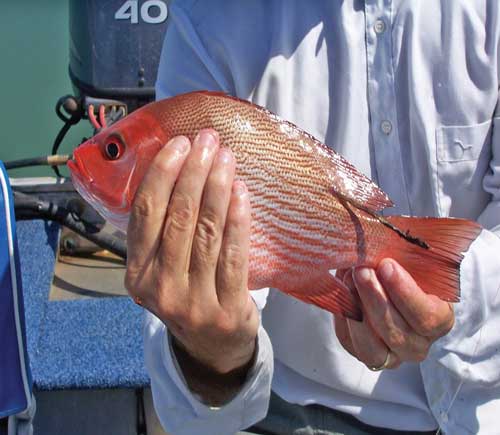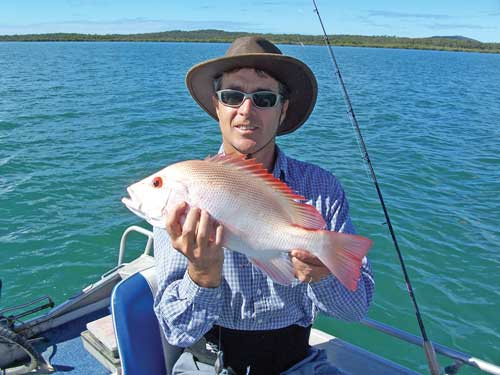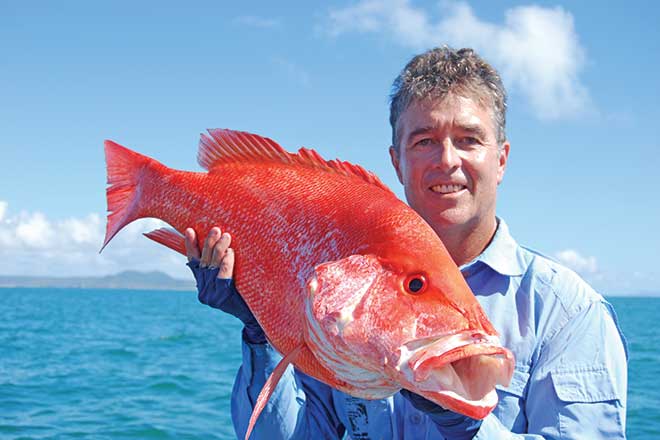In his paper entitled ‘Critique of and alternatives to proposed changes to the management of saddletail and crimson snapper’, Klim Martin discusses the proposed modifications by Queensland Fisheries to the managing of these species on the east coast of Queensland, as at March 2024.
Saddletail and crimson snapper have a number of common local names, including red jewfish, large-mouth nannygai and small-mouth nannygai.
For the purposes of this paper, we will use the most common names – being large-mouth nannygai, which are saddletail snapper, and small-mouth nannygai, which are crimson snapper.
They aren’t true nannygai but members of the lutjanid family, which also includes red emperor, mangrove jack and fingermark.

Nannygai stocks
It is almost impossible to find anyone who has fished for nannis for decades in central Queensland specifically, but almost certainly in other parts of north Queensland as well, who believes stocks are in serious decline.
In fact, many are reporting seeing more schools and catching more nannis than ever in recent years.
How can this be?
Fishing effort has undoubtedly increased, with bigger boats and better technology, so intuitively you might expect to see a reduction in stocks.
Think about it… we have had extensive green zones covering large expanses of prime nanni habitat since 2004, affording protection to spawning aggregations and stocks in general.
On top of that, nanni habitat was traditionally trawled relentlessly, destroying critical soft coral habitat and breaking up the schools of fish that call that habitat home.
The trawl fleet has been significantly rationalised over the past couple of decades and we don’t see the level of habitat destruction we used to.
The combination of these two positive impacts for large-mouth nannygai and small-mouth nannygai are the most likely explanation for the resurgence of stocks of these species.
As a consequence, recruitment must be better than it has been for many decades and reports of extensive juvenile nanni schools in inshore areas along the coast are coming in all the time.
The abundance of juvenile schools along the coast and clear success of recruitment in recent years appears not to have been included in departmental stock assessment calculations.
What a critical oversight.

Effectiveness of minimum size limits
Every thinking and responsible recreational fisher wouldn’t argue that minimum size limits are a good idea and should provide a measure of protection to ensure fish have an opportunity to spawn at least once.
However, there are exceptions and nannis are a classic example.
Large-mouth nannygai suffer terribly from barotrauma, only equalled by tuskfish in the offshore reef fishing environment.
Barotrauma is essentially the fish getting the bends due to being quickly pulled from deep water to the surface.
Typical offshore nanni habitat is soft coral plains and wonky hole country in water depths between about 25m and 60m.
Lethal barotrauma in large-mouth nannygai occurs as soon as the water depth you catch them in exceeds about 15m.
So, that clearly means pretty much 100 percent of current undersized fish caught in offshore waters will be discarded dead or dying.
Quite apart from the obvious waste of a resource, it is also a significant contributor to the shark depredation problem everyone is experiencing.
Of course, sharks have learnt quickly that nanni fishers are a great source of free food, with all the dead undersized fish tossed back.
I know of many thinking fishos who now keep their undersized nannis onboard until they have finished fishing, move off the grounds and then discard the undersize fish so as not to train the sharks in that area.
While a very common-sense idea, it is technically against the rules.
The bottom line is these fish are dead, and dead is dead whichever way you look at it.
From a sound fisheries management principle, this is plain stupid.
Let’s examine what might be a typical offshore recreational fishing trip targeting large-mouth nannygai – few fishos actually actively target small-mouth nannygai.
If they found a school to fish, two fishers in a boat would likely catch between two to six undersized (<40cm) large-mouth nannygai in the course of the fishing session.
On a good day, they might also expect to catch up to their current individual bag limit of nine legal-sized nannis too.
Now think about this – if the two fishers manage to catch close to their bag limit of large-mouth nannygai, they will probably have killed around 23 fish, and unfortunately some trips may be many more, if there are a lot of small fish in the school.
Most responsible fishers deplore killing fish they don’t intend to keep and hate having to throw back perfectly good dead fish.
But what if we changed our paradigm?
If the bag limit for large-mouth nannygai also included all undersized fish, say above 35cm, our two fishers above would kill around 18 fish instead of 23 plus for the trip – a reduction in mortality of around five to six fish.
Surely that is a good outcome for the fish stocks?
If the minimum legal size of large-mouth nannygai is increased to 55cm as proposed, and even if the bag limit was reduced to four per person, that same trip would see the killing of as many as 30 plus fish in the course of catching four fish larger than 55cm.
Seriously?
Currently, a typical two fisher large-mouth nannygai trip would see no more than 50 percent caught being larger than the proposed 55cm minimum size, in central Queensland at least, and often far less than this percentage depending on the school you find.
So under the new proposals, instead of killing possibly 23 fish for a trip as it now stands, we could be forced to kill well in excess of 30 fish just to keep four and get a decent feed.
To repeat the blinkingly obvious – that makes no sense!
In the scenario where large-mouth nannygai fishos would be required to keep the undersize fish and count them towards their bag limit of nine fish, the total fish killed for the trip would be only 18.
That is five to six less than the current situation and quite significant in the greater scheme of things.
Now which has the best outcome for fish stocks?
It’s a no brainer.

Social media has a lot to answer for
Stupidly, people are posting pictures of very large catches of nannis taken by crews of four to five people.
The total catch is probably within the existing bag limit, yet it looks awful.
In truth, it probably isn’t having a huge negative impact on stocks but still, it looks bad and is being used against recreational fishos by fisheries managers and others outraged at what they are seeing.
The possible solution and easiest way to address this without creating a world war is to put a boat limit in place.
That means no matter how many fishers are onboard, once the total catch of the boat reaches a certain number, no more can legally be caught.
This concept is already in place for spanish mackerel.
Such a large-mouth nannygai boat limit could be somewhere in the region of 18-20, for example.
This would allow larger crews to still catch a decent feed and the perception of excessive harvesting would be addressed.

Question without notice
Do you think there are more coral trout or nannygai off the east coast of Queensland?
Apart from a few delusional people in Fisheries, almost nobody who regularly fishes offshore waters would say coral trout.
The majority of fishos canvassed responded by being extremely confident that there would be far more large-mouth nannygai and small-mouth nannygai off the coast than coral trout.
The rationale is that nannis aggregate in large schools across vast areas of suitable habitat and are only targeted by line fishing, which is one of the most inefficient ways of catching fish.
Also, nannygai habitually move around often and probably over fairly large areas, making it quite difficult to confidently predict where they are going to be on any given day or tide.
And, to top it off, nannis have a distinct ‘bite time’ during which they are readily catchable, however after that limited time they appear not to feed, regardless of what is presented to tempt them.
It is because of the combination of factors affecting catchability that experienced fishers do not believe line fishing poses any serious threat to stocks at this point in time.
So, what is the significance of the question?
Fisheries currently allow an annual total allowable commercial harvest of coral trout of slightly over 900 tonnes.
Add to that the guestimate of the collective recreational catch and the overall harvest is probably well north of 1200 tonnes per year.
Apparently, even with that annual harvest, coral trout stocks are supposedly at a healthy 60 percent of unfished biomass.
Now we’ve just speculated that there are more nannygai in the water than coral trout, with Fisheries’ best guess at harvest levels for nannis currently being about 180 tonnes per year by the recreational sector and 80 tonnes by the commercial sector, totalling only 260 tonnes all up.
Compare that to the coral trout harvest and… you should be scratching your head by now.
Blind Freddy can see there is something radically wrong with Fisheries’ argument and rationale here for screwing back the recreational share of the catch of nannygai.
Fisheries will respond by claiming that their stock assessment of only 23 percent for saddletail is accurate and that’s why we aren’t catching thousands of tonnes of nannis.
Solid grade three logic, but it doesn’t stand up in fisheries management, except for in Queensland of course.
Simple to refute their logic though.
All we need to do is ask for the hours spent targeting coral trout and saddletail by the commercial sector and the folly will be abundantly clear.
Commercial line fishers spend the greater part of their time targeting coral trout!
Is the supposed 23 percent stock assessment credible?
Unfortunately, no.
There were high hopes that the latest and greatest stock synthesis model for stock assessment was going to finally provide consistent and credible stock assessments, though sadly this simply wasn’t the case.
How can anyone who has been involved in our fishery for decades accept that the model is delivering reliable and credible stock assessments when it states our east coast king threadfin stocks are at a healthy 70 percent of unfished biomass, while saddletail are at a disastrously low 23 percent?
And we won’t even touch on what’s happening with spanish mackerel.
Everyone knows that threadfin stocks are but a shadow of what they were even as recently as the 1950s and anything north of about 25 percent at best is simply laughable.
So, let’s simply bin the 23 percent for saddletail and talk about what we should be doing to ensure current harvest levels by both sectors don’t have the capacity to rapidly increase.

Why this is being inflicted on recreational fishers
The answer is two-fold.
First, as indicated earlier, rec fishos are by and large incredibly socially conscious and, because rec fishers go fishing for a variety of reasons – none of which include making money – the sector has always been quick to put up their collective hands and accept ‘responsible restrictions in size and bag limits’ in the name of looking after fish stocks.
Nothing wrong with that and rec anglers should be congratulated for it, but sadly those good natures and intentions have brought the sector undone repeatedly over the past 30 years.
Fisheries have taken advantage of rec fishers’ good nature and general apathy to progressively screw down the sector’s catch, while maintaining or increasing the allowable commercial harvest of the same species.
This is called ‘resource reallocation’ in Fisheries speak.
“You get this much and I get this much of what you used to get on top of my bit already.”
“Good deal for me, eh?
“Not so good for you though.”
It always seems to end up with the recreational sector being screwed down and more of what we’ve historically caught being reallocated to the commercial fishers.
Whiting, bream, tailor, school and spotted mackerel and black jewfish are a few classic examples of how the recreational sector has been swindled out of their majority share of species that were always theirs.
Second, some rec fishos naively poop in their own nest by posting photos of large hauls of fish.
Uninformed viewers and others with an axe to grind grab these images and use them to lambast all recreational fishers who they now believe regularly go out and rape and plunder the fish stocks.
Of course that isn’t the case, though the media never lies, does it?
There are the pictures to prove it.
Fisheries love this too because they have data that confirms there are 800,000 or more rec fishos in the state and they look at large catch photos and do some dodgy multiplication that shows suddenly rec anglers are overfishing the resource.
I bet most of you only wish you could catch enough fish for a decent meal for the family.
So, if you really want to help the cause, stop posting skite photos of your once in a while good catches.

Solution
Here’s a solid proposition:
- Set the bag limit for large-mouth nannygai (saddletail snapper) at eight per person and an 18-20 boat limit for more than three people onboard for offshore waters deeper than 10m
- Set the small-mouth nannygai (crimson snapper) bag limit at four per person – no need for a boat limit as most fishos don’t keep many, if any
- Minimum size limit of 35cm to apply in offshore waters and all fish caught above this size must be retained and counted towards the bag limit
- Minimum size limit of 40cm retained for large-mouth nannygai caught in estuaries and along the coast in water less than 10m deep, with a bag limit of four fish – undersized fish can be successfully released in shallow water
- Put in place an overall commercial total allowable catch of 100 tonnes per year for the east coast to ensure there is no significant movement towards these species in future.
Everybody will be fairly happy and stocks will continue to grow without a doubt, and shark depredation might even decrease over time in this fishery.

Fast facts from tagged nannygai
Over a period of years in Head Creek, at the very southern end of Shoalwater Bay, CAPTAG members caught and tagged no less than about 1200 saddletail and 550 crimson snapper.
These are the results of saddletail and crimson snapper tagged in lower Shoalwater Bay by CAPTAG 2005-2015.
About 1200 saddletail snapper (large-mouth nannygai) were tagged.
About 550 crimson snapper (small-mouth nannygai) were tagged.
All these fish were tagged in water between 5-10m deep only.
Barotrauma was not an issue.
A total of 190 individual saddletail snapper were recaptured, which is a recapture rate of 22.7 percent.
A total of 59 individual crimson snapper were recaptured, which is a recapture rate of 14.6 percent.
A total of 70 saddletail and crimson snapper were recaptured twice, while four saddletail snapper were recaptured four times.
Of the 274 saddletail snapper recaptures (about 23 percent), there were 208 fish used for growth, with an average annual linear growth of 74mm per year.
Of the 83 crimson snapper recaptures (about 15 percent), there were 51 used for growth, with an average linear growth of 55mm per year.
A total of 257 fish had sufficient data to determine movement.
Of these fish 246 (95.7 percent) were caught in the same area they were tagged, with movement of less than 1km.
A small number (seven) of fish that were tagged at Cockatoo Island were recaptured about 2km further down the creek at the other location where fish were tagged.
A saddletail snapper tagged on trip 14 in Head Creek was recaptured in the same area on trip 16, then was recaptured 881 days from when tagged in December 2008 at High Peak Island, 80km to the north.
It was 330mm when tagged and 550mm when recaptured.
Another saddletail snapper tagged on trip 23 in Head Creek was recaptured 200 days later at Red Clay Island, 125km to the northwest.
This fish was 240mm when tagged and 250mm when recaptured.
Head Creek and other creeks in Shoalwater Bay are used by juvenile saddletail snapper and crimson snapper and they do not move significantly while in the creeks.
Movement is likely to be associated with fish maturing and moving to adult habitats offshore, though one movement was by a juvenile fish.
Distances moved to adult habitats are generally substantial and often in excess of 50km.
 Bush 'n Beach Fishing Magazine Location reports & tips for fishing, boating, camping, kayaking, 4WDing in Queensland and Northern NSW
Bush 'n Beach Fishing Magazine Location reports & tips for fishing, boating, camping, kayaking, 4WDing in Queensland and Northern NSW








